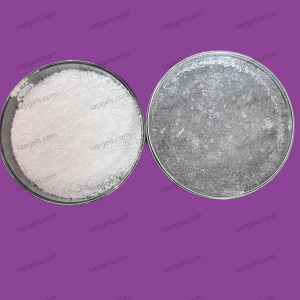I. Classification of Polymères super absorbants
Super absorbent polymers (SAPs) can be categorized based on their chemical composition:
- Polyacrylate-based SAPs: These are the most prevalent types of SAPs, synthesized from acrylic acid or its salts, such as sodium polyacrylate.
- Polyacrylamide-based SAPs: Derived from acrylamide, these SAPs are commonly used in agricultural and horticultural applications.
- Natural Polymer-based SAPs: Sourced from natural materials like starch, cellulose, and chitosan, these SAPs are biodegradable and environmentally friendly.
- Hybrid SAPs: These are a blend of synthetic and natural polymers, designed to harness the best properties of both types.
- GELSAP Hydrogel and Artificial Snow: Specialized applications of SAPs in creating hydrogels and artificial snow.

II. Development of Industrial Applications of Polyacrylate-Based SAPs
The evolution of industrial applications for polyacrylate-based SAPs can be traced through several stages, from initial research to widespread commercial use:
- Research and Development Stage (1950s to 1960s):
- Late 1950s: Chemists began studying polymers with high water absorption capacity.
- 1960s: Researchers at the United States Department of Agriculture (USDA) discovered a polyacrylate-based polymer capable of absorbing significant amounts of water, laying the groundwork for the development of SAPs.
- Early Commercialization (1970s to 1980s):
- 1970s: The first generation of polyacrylate-based SAPs was introduced in agriculture and horticulture as soil moisturizers.
- 1980s: These SAPs became widely used in hygiene products like diapers and sanitary napkins due to their superior water absorption, driving further research and development.
- Widespread Application and Technological Improvement (1990s to 2000s):
- 1990s: Advances in production technology significantly improved the quality and performance of polyacrylate-based SAPs. Their use in hygiene products expanded, gradually replacing traditional absorbent materials.
- 2000s: Research focused on enhancing water absorption rate, capacity, and biodegradability. New applications in medicine, food packaging, and construction were also explored.
- Continuous Innovation and Diversified Applications (2010s to Present):
- 2010s: Increasing environmental concerns shifted the focus towards natural substrate-based and biodegradable polyacrylate SAPs. High-performance SAPs for medical, industrial, and specialized fields were also developed.
- 2020s: The application of polyacrylate-based SAPs broadened, particularly in smart agriculture, controlled drug release, waste liquid treatment, and environmental remediation. Research now emphasizes sustainability and versatility to address growing environmental and resource challenges.
Key Development Trends
- Environmental Friendliness and Biodegradability: With rising environmental awareness, there is a significant shift towards developing biodegradable and eco-friendly SAPs. Scientists are exploring natural materials like cellulose and starch for creating easily biodegradable SAPs. Efforts are also being made to modify synthetic polymers to improve biodegradability without compromising performance.
- High Performance and Multifunctionality: Enhancing the water absorption capacity of SAPs remains a priority, aiming to develop products that absorb and retain more liquid quickly. New functionalities are being integrated into SAPs for greater versatility, such as controlled-release agents for fertilizers in agriculture and drug delivery systems in the pharmaceutical industry.
- Smart Applications: Advances in IoT and smart control technologies are enabling SAPs to be used in smart agriculture and intelligent packaging. In agriculture, SAPs help regulate soil moisture and monitor plant health, providing real-time data for better crop management. In packaging, SAPs maintain optimal humidity levels, extend product shelf life, and offer freshness indicators.
Commitment to Innovation and Environment
At GELSAP, we prioritize innovation and environmental stewardship. By focusing on bio-based product development, we address industry needs while promoting ecological balance. Our goal is to provide high-performance materials that meet modern application demands while ensuring positive environmental impact.
Future Prospects
Our ongoing efforts to expand the bio-based product line aim to enhance the sustainability and performance of our polymers. Driven by a vision of balancing industrial growth with environmental responsibility, GELSAP is pioneering a sustainable future. We invite you to explore the benefits of our innovative bio-based products.
References
- USDA (1960s). Development of polyacrylate-based polymers for water absorption. United States Department of Agriculture.
- USDA (1970s). Early applications of polyacrylate-based SAPs in agriculture and horticulture. United States Department of Agriculture.
- USDA (1980s). Widespread use of polyacrylate-based SAPs in sanitary products. United States Department of Agriculture.
- USDA (1990s). Advancements in production technologies for polyacrylate-based SAPs. United States Department of Agriculture.
- USDA (2000s). Research and applications of SAPs in various fields. United States Department of Agriculture.

